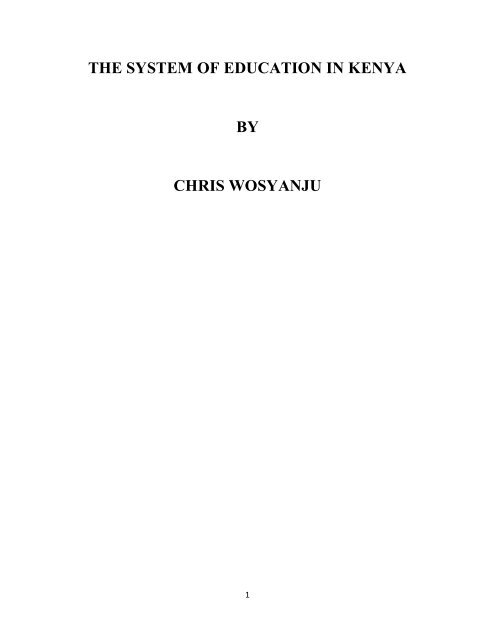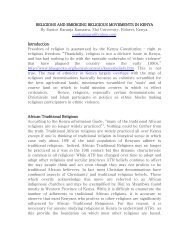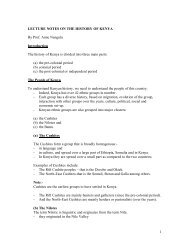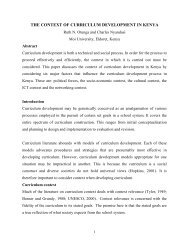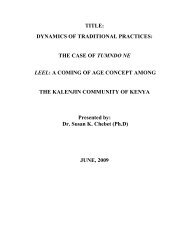THE SYSTEM OF EDUCATION IN KENYA - International Affairs
THE SYSTEM OF EDUCATION IN KENYA - International Affairs
THE SYSTEM OF EDUCATION IN KENYA - International Affairs
You also want an ePaper? Increase the reach of your titles
YUMPU automatically turns print PDFs into web optimized ePapers that Google loves.
TERTIARY <strong>EDUCATION</strong>For students who go on to higher education in Kenya, there are seven public universities and 17private universities with either full or interim charter. In addition to adding technical courses atthe primary and secondary school level, vocational education has been a focus of the educationsystem. The Ministry of Higher Education has developed a national strategy for technical andvocational education and training aimed at the rehabilitation of physical facilities and equipmentand ensuring that vocational and technical institutions are appropriately equipped by 2010(UNESCO, 2006) and there many two and three colleges which offer certificate diplomaprograms. These public and private colleges offer technical hands-on skills in various fieldsincluding, engineering, medical sciences, nursing, education, computer science, masscommunication, tourism, and business.EnrollmentKenya has 7 public and 17 private universities with an enrollment of about 50,000 students.Roughly 80% are enrolled in public universities, while 20% of the total university studentpopulation attends private universities.More than 60,000 students enroll in middle-level colleges. The middle-level colleges cater to avariety of post-secondary career courses leading to certificate, diploma, and higher diplomaawards. By 1990, Kenya had about 160 middle-level colleges; by 2000 it is estimated that thecountry had more than 250 of them.6
Undergraduate Student Enrollment at Kenyan Public andPrivate Universities1996-97 through 1999-2000 (Academic Year)PublicUniversities1996-97 1997-98 1998-99 1999-2000M F M F M F M FNairobiUniversityKenyattaUniversityJKUATUniversityEgertonUniversityMoiUniversityMasenoUniversity10,102 3,558 9,347 3,232 8,976 3,449 8,489 3,4405,520 3,054 4,530 2,613 4,738 3,020 4,189 3,0071,818 417 2,556 452 2,471 621 2,512 6255,445 2,340 5,705 2,331 5,654 2,519 7,132 2,841- - 3,588 1,363 3,705 1,418 4,136 1,6491,739 859 1,860 949 2,687 1,312 2,044 1,211Subtotal 24,624 10,228 27,586 10,940 28,231 12,339 28,502 12,773PrivateAccreditedDaystarUniversityBaratonUniversityCatholicUniversity559 691 565 727 720 961 861 1,417489 433 470 372 498 454 537 507569 638 - - 742 660 807 810U.S.I.U. 852 901 868 940 902 999 928 1,0327
Administrative StructureUniversity councils are charged with the responsibility of policy formulation, creation offaculties and departments, and approval of the appointment of university staff. The universitysenate is responsible to the council for academic affairs, financial, and administrativemanagement of the university. Senates are presided over by vice-chancellors and are dominatedby heads of departments who are potential vice-chancellors. Under the senate, faculty boards anddepartments, oversee instruction and also administer examinations. Except for the faculty deans,staff, and student representatives on university councils, all the other officers are appointed.Funding and ResourcesUntil the early 1970s, university education in Kenya was free and the full cost was borne by thegovernment. During the 1991-92 academic year, the government introduced a cost-sharingscheme that required students to pay direct fees of US$80 to US$107 annually per student andtotal charges were raised to US$667.The funding of public universities in Kenya is currently based on unit cost. The current unit costof US$1,600 is comprised of tuition of US$1,147 and catering, accommodation, and other coststhat amount to US$453. The method does not take into account differential costs of the variousdegree programs.Research and PublishingIn the 1970s and early 1980s, the volume of research carried out at the University of Nairobi, theoldest and biggest public university in the country, was one of the highest in Africa. One of thekey factors that has stunted the growth of research in the Kenyan university system is lack ofadequate research funds.The large portion of support (although inadequate) for postgraduate and staff training andresearch work comes from donors and international organizations. Lack of adequate qualifiedresearchers constitutes the second major constraint to research expansion.Gender IssuesIn spite of this massive expansion, gender and regional imbalances have shaped and continue toshape the development of higher education in Kenya as in other African countries. Theproportion of girls’ enrollment declines as they move up the educational ladder. As a result,female students make up about 30 percent of total enrollments in the public universities. Femalestudents' under-representation is higher in engineering and technical-based professionalprograms.Gender parity is evident in all the accredited private universities, with women comprising 54.5%of the 1999-2000 total student enrollment. Most women enroll in private universities becausethey fail to secure admission into the public universities, and also due to the fact that the courseofferings in these institutions are in the social sciences, education, arts, business administration,accounting, and computer science.9
MANAGEMENT <strong>OF</strong> <strong>EDUCATION</strong>The Ministry of Education is responsible for providing education to its citizens (Ministry ofEducation, 2008). The ministry’s tasks include employment of teachers for government schools,distribution of learning resources, and implementation of education policies. It is responsible forseveral sectors in education including: 1) Early Childhood Development and Pre-PrimaryEducation; 2) Primary Education; 3) Special Needs Education; 4) Secondary Education; 5)Teacher Education (Primary Teacher Education, Diploma Teacher Education, and In-ServiceTraining Program).The education sector takes up about 30% of the government’s annual expenditure accounting forthe largest share of the annual budget. The expenditure is distributed as follows:Pre-Primary Education 0%Primary Education 55%Secondary Education 27%Tertiary Education 16%Other 2%(UNESCO 2008b)University education falls under the Ministry of Higher Education, Science, and Technology.The ministry’s mandates are: 1) Science Technology Innovation (STI) Policy; 2) Researchdevelopment, research authorization; and 3) Coordinating Technical Education (TE). Amongother roles, the higher education ministry is responsible for improving the quality, relevance,equity and access to higher education and technical training and to enhance the capacity of thenational STI system towards demand driven STI, quality higher education and technicaleducation services (Ministry of Higher Education, Science, and Technology, 2009).The vision of the Ministry is to provide “quality education for development," while its mission is“to provide, promote and co-ordinate lifelong education, training and research for Kenya'ssustainable development.” MoE focuses on certain priority areas, notably attaining UniversalPrimary Education (UPE) by 2105 within the context of the wider objective of theUNESCO/World Bank initiative Education for All (EFA) (Ministry of Education, 2008;UNESCO, 2006). The Ministry has several objectives:1. Achieve EFA by 2015;2. Achieve transition rate of 70% from 57% for primary to secondary school;3. Enhance access, equity and quality in primary and secondary education; and4. Develop a national strategy for technical and vocational education and training leading tothe rehabilitation of the physical facilities and equipment and making sure that vocationaland technical institutions are appropriately equipped by 2010;10
5. Expand public universities and increase the number and proportion of all studentsstudying science subjects to 50%, with at least one third being women by 2010; and6. Achieve 50% improvement of adult literacy by 2015 (Ministry of Education, 2008).The Kenya Institute of Education (KIE), a semi-autonomous governmental agency, isresponsible for educational research and development of the curriculum. KIE is focused onproviding quality, relevant and affordable educational and training programs in response to achanging social, economic and technological environment. The initiatives are met throughcontinual research, evaluation, assessment and the monitoring processes (Kenya Institute ofEducation, 2009). KIE works closely with the Kenya National Examination Council (KNEC),the examining body responsible for developing and assessing national exams at various levels oflearning including the Kenya Certificate of Primary Education (KCPE) and Kenya Certificate ofSecondary Education (KCSE) (Kenya National Examination Council, 2008). The TeachersService Commission (TSC) is responsible for teacher recruitment, human resources services, andplace of government employed teachers (Ministry of Education, 2008).KIE is responsible for: 1) Conducting research and evaluation in education and training; 2)Designing and developing curriculum for all levels of education and training below theuniversity level; 3) Developing learning resources, including books, manuals, and multimediaresources; 4) Conducting in-service training of teachers and trainers on new curriculum andtrends in education and training; 5) Conducting dissemination programs for educationadministrators, evaluators, book publishers and other stakeholders; 6) Carrying out evaluation ofbooks to access their suitability; and 7) Developing on consultancy basis, programs for schools,colleges, organizations and technical training institutions.Kenya Vision 2030Kenya Vision 2030 is the nation’s new development blueprint for 2008 to 2030 which aims atmaking Kenya a newly industrializing, “middle income country providing high quality life for allits citizens by the year 2030” (NESC, 2007). The plan is to be implemented in successive fiveyearterms with the first plan covering 2008-2012. The education goals of the 2030 Vision are toprovide globally competitive quality education and training and research for development. Thisis to be achieved through reducing literacy by increasing access to education, improving thetransition rate from primary to secondary schools, and raising the quality and relevance ofeducation. Other goals are the integration special needs education into learning and traininginstitutions, and increasing the adult literacy rate to 80%. The government also aims to increasethe enrollment in schools to 95% as well as the transition rates to technical colleges and highereducation to 8%. In addition, the rate of students joining universities should expand from 4.6% to20% within this period, while simultaneously boosting emphasis on science and technologycourses.The government has specified the implementation strategies which include integrating earlychildhood into primary education, reforming secondary curricula, updating teacher education,and strengthening partnerships with the private sector. In addition, the government has goals toimprove special needs programs and adult training program, and to revise the higher educationcurriculum. Specific educational development projects for 2012 are to increase the number of11
secondary schools by building 560 new secondary schools, to establish a teachers’ recruitmentprogram to employ 28,000 more teachers, to establish a computer supply program that will equipstudents with modern ICT skills, to build at least one boarding primary school in eachconstituency in the pastoral districts for nomadic populations, and to roll out the educationvoucher system program in five districts.Vision 2030 also aims to capitalize on knowledge in science, technology and innovation (STI) inorder to function more efficiently, improve social welfare, and promote democratic governance.STI is to be applied in all the sectors, and the education and training curricula in the country willthus be modified to ensure that the creation, adoption, adaptation and usage of knowledgebecomes part of formal instruction. A new incentive structure will also be developed to supportthe use of STI in specialized research centers, and universities.Conclusion:Kenya has a very dynamic education system which has been undergoing reforms to respond tosocial and economic factors.Currently, the pre-primary school education is not funded by the government, but pressure hasbeen mounting for the government to take over and fund these schools.The primary school enrolment has is approaching 100%, but there are serious questions ofquality due to overcrowding and lack of teachers.Secondary school enrolment is still very low (less than 50%), and it is even lower for girls. Thisis an issue that requires to be addressed urgently.At University level, enrolment is estimated at only 3%, despite the phenomenal increase in thenumber of universities over the last few years. Universities also lack funding for research andinnovation. One way out of this is to foster links with other universities where in order to carryout reaserach in a collaborative manner. In these way, researchers can also learn from each other,and with time, Kenya can have a pool of trained and experienced researchers to tackle thecountry’s problems, especially in relation to vision 2030 and the millennium Goals.12
ReferencesBuchmann, C., 1999. The state and schooling in Kenya: Historical developments and currentchallenges. Africa Today 46 (1), 95-117.CIA World Fact Book - Kenya. 2008. Retrieved March 12, 2008, fromhttps://www.cia.gov/library/publications/the-world-factbook/geos/ke.htmlCoppola, C., and Neelley, E., 2004. Open source - opens learning: Why open source makes sensefor education [Electronic Version], fromhttp://dlist.sir.arizona.edu/453/01/OpenSourceOpensLearningJuly2004.pdfEducation Info Center, 2006. Kenya High Commission, Ottawa Canada. Retrieved March 1,2008, from http://www.kenyahighcommission.ca/primary.htm<strong>International</strong> Bureau of Education, 2004. Development of Education in Kenya [Electronic.(2004). Version]. Retrieved March 18 2007, fromhttp://www.ibe.unesco.org/<strong>International</strong>/ICE47/English/Natreps/reports/kenya.pdfFord, D. M., 2007. Technologizing Africa: On the bumpy information highway. Computers andComposition, 24 (3), 302-316.Fourie, M., and Alt, H., 2002. Challenges to Sustaining and Enhancing Quality of Teaching andLearning in South African Universities. Quality in Higher Education, 6 (2), 115-124.Free Primary Education in Kenya: One of Kibaki’s Trump Cards? April 11 2007. AfricanPath, Retrieved March 19, 2009 fromhttp://www.africanpath.com/p_blogEntry.cfm?blogEntryID=584Free Secondary Schools for Kenya, Feb 11, 2008. BBC News. Retrieved fromhttp://news.bbc.co.uk/2/hi/africa/7239577.stmKenya - Data and Statistics., 2008. World Bank. Retrieved March 18, 2008, fromhttp://web.worldbank.org/ ........ PK:356509,00.htmlKenya Institute of Education, 2009. About the Kenya Institute of Education. Retrieved March19, 2008, from http://www.kie.ac.ke/about/index.phpKenya National Examination Council, 2008. KNEC. Retrieved March 19, 2008, fromhttp://www.examscouncil.or.keMinistry of Education, 2008. About the Ministry. Retrieved March 11, 2008, fromhttp://www.education.go.ke/Resources.htm13
Ministry of Education, Science and Technology, 2008. Mandate. Retrieved March 19, 2009 fromhttp://www.scienceandtechnology.go.ke/Mukudi, E., 2004. Education for all: A framework for addressing the persisting illusion for theKenyan context. <strong>International</strong> Journal of Educational Development 24 (231-240).National Economic and Social Council of Kenya (NESC), 2007. Kenya Vision 2030. RetrievedMarch 17, 2009, fromhttp://www.investmentkenya.com/Documents/Publications/Vision_2030_BROCHURE%20_July_2007.pdfUNDP, 2008. Millennium Development Goals (MDGs). Retrieved March 15 2009, fromhttp://www.undp.org/publications/MDG_Report_2008_En.pdfUNESCO, 2008a. EFA Global Monitoring Report 2008.http://www.unesco.org/en/education/efareport/reports/2008-mid-term-review/UNESCO, 2008b. UNESCO Institute for Statistics: UIS Statistics in Brief. Retrieved March 122008, fromhttp://stats.uis.unesco.org/unesco/TableViewer/document.aspx?ReportId=121&IF_Language=eng&BR_Country=4040UNESCO, 2008c. Kenya Basic Education Indicators. Retrieved March 1, 2008, fromhttp://www.education.nairobi-unesco.org/PDFs/kenya.pdf14


